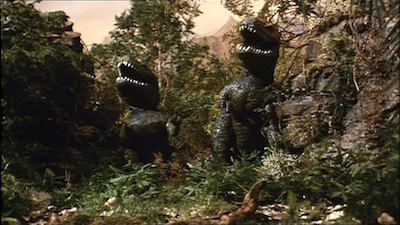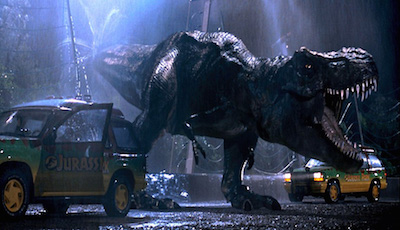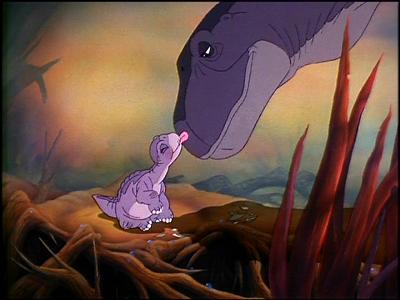 Though the competition is great, I vote the sequence where the T-rex emerges from the rain and the darkness in Jurassic Park as the best directed and most suspenseful action sequence in all of Steven Spielberg’s movies, including my beloved Jaws. My girlfriend gripped my hand tight; the audience around us screamed and laughed, at the little humorous beats slipped seamlessly into the breath-holding dinosaur action. I had a different reaction.
Though the competition is great, I vote the sequence where the T-rex emerges from the rain and the darkness in Jurassic Park as the best directed and most suspenseful action sequence in all of Steven Spielberg’s movies, including my beloved Jaws. My girlfriend gripped my hand tight; the audience around us screamed and laughed, at the little humorous beats slipped seamlessly into the breath-holding dinosaur action. I had a different reaction.
Tears.
I wasn’t crying, exactly. These were happy tears, grateful tears. After a lifetime of dinosaur love, I felt I had really seen one, up close. The T-rex was everything I imagined a living, breathing dinosaur to be. At an age where I thought I had well and truly put “childish” things aside, I was amazed to be rediscovering those feelings again, as if I were back in my room, leafing through Worlds of the Past (my very favorite dinosaur book, with its colorful illustrations), looking at View-Master reels of the creatures, taken from the 1956 film The Animal World, and patiently awaiting our next trp to the American Museum of Natural History to gawk at the fossils. I’ve loved dinosaurs for so long I’ve seen Brontosaurus go to Apatosaurus and back again.
 Cinematically, however, I grew up dino-deprived. Old movies helped: King Kong (1933) and One Million Years B.C. (1966), with their wonderful Willis O’Brien and Ray Harryhausen creations, were viewed as often as they were scheduled, back in my prehistoric, no cable- and no-VCR youth. (“Obie” and Harryhausen, whose work instilled in me a love of film craft, collaborated on that ten-minute Animal World vignette, which for years was only viewable via those View-Master reels.) New films, however, were difficult to come by (Godzilla and his ersatz saurian friends were a separate pleasure, who didn’t really count, and by the 70s they were in crisis, too.) My dad took me to see The Land That Time Forgot (1975), which was sort of a thrill, though my discerning nine-year-old eyes knew that the stop-motion dinos who occasionally visited Channel 9 or “The 4:30 Movie” were a lot more convincing than the puppety, string-hoisted “man-in-suitasaurauses” of my era. King Kong (1976) was a complete bust, with just one fake giant snake to confront Kong on Skull Island. (Peter Jackson’s 2005 remake may be lousy with dinosaurs, but I wasn’t complaining.) That I was the only 19-year-old to actually buy a ticket to see 1985’s Baby: Secret of the Lost Legend, a Disney stiff, speaks to the depths of my, and our, onscreen dino drought.
Cinematically, however, I grew up dino-deprived. Old movies helped: King Kong (1933) and One Million Years B.C. (1966), with their wonderful Willis O’Brien and Ray Harryhausen creations, were viewed as often as they were scheduled, back in my prehistoric, no cable- and no-VCR youth. (“Obie” and Harryhausen, whose work instilled in me a love of film craft, collaborated on that ten-minute Animal World vignette, which for years was only viewable via those View-Master reels.) New films, however, were difficult to come by (Godzilla and his ersatz saurian friends were a separate pleasure, who didn’t really count, and by the 70s they were in crisis, too.) My dad took me to see The Land That Time Forgot (1975), which was sort of a thrill, though my discerning nine-year-old eyes knew that the stop-motion dinos who occasionally visited Channel 9 or “The 4:30 Movie” were a lot more convincing than the puppety, string-hoisted “man-in-suitasaurauses” of my era. King Kong (1976) was a complete bust, with just one fake giant snake to confront Kong on Skull Island. (Peter Jackson’s 2005 remake may be lousy with dinosaurs, but I wasn’t complaining.) That I was the only 19-year-old to actually buy a ticket to see 1985’s Baby: Secret of the Lost Legend, a Disney stiff, speaks to the depths of my, and our, onscreen dino drought.
Reanimating my boyhood passion, and at last satisfying my craving for real reel dinosaurs, Jurassic Park changed everything for me. Twenty-two years later here we are at Jurassic World, a half-billion dollar grossing sensation, and I know what you’re thinking: The old fart hates it. Get off my lawn, Indominus rex. Not so. How could I hate a movie that opens with a kid looking at those exact same View-Master reels? “Have you seen my childhood?” Michael Jackson once sang, plaintively. I saw mine, Michael, right up there on the big screen at the Ziegfeld in New York, in Jurassic World–which is about as good as any not-really-necessary third sequel, coming a full 14 years after the last installment, can be.
But there are bones to pick. (Spoilers ahead.) One is technical: The 3D processing, or lack thereof. Mainstream reviews rarely bother to mention 3D anymore, and as someone who loves 3D I live in hope of a first-rate presentation, one with good depth and decent “pop-out” effects, the kind we got in the 80s and in the 50s, as in the beautifully rendered John Wayne film Hondo (1953), which I happened to see in a rare revival right before Jurassic World. A handful of contemporary movies, like Pacific Rim, X-Men: Days of Future Past, and Mad Max: Fury Road, get it right. Jurassic World, a film with limited depth of field and zero pop-out, doesn’t get it at all. This is a movie set in a dinosaur theme park, for goodness sake, not a highbrow prestige film or a John Updike adaptation–let’s go deep into the grounds with them, let’s get those bad boys in our face. Nothing, as opportunties whiz by like raptors in what’s been referred to as “2.5D.” We expect so little from entertainment these days, and the multiplex-crushing popularity of Jurassic World, from Scranton to Shanghai, means we’ll be getting more conservative and unspectacular 3Duds for years to come.
 The other is emotional. The great scene in Jurassic Park is that T-rex attack; the great moment is when Sam Neill’s paleontologist comforts the girl in his care by correcting her fears, saying that the beasts all around them are “animals, not monsters.” Lovely. But that sense of wonder has diminished over time, starting with the two sequels that the new movie ignore. It can: They take place on a different island. We can’t: besides frequent shout outs to the original (the two leads cradling a sick or injured herbivore, an enclosed vehicle chomped on by a carnivore, etc.) , Jurassic World reprises action and plot points from the others, with the reckless poachers in The Lost World: Jurassic Park (1997) transformed into feckless paramilitary types pursuing the “world’s scariest dinosaur,” which we thought we saw in Jurassic Park III (2001). (Did you complain when Back to the Future II replayed rejiggered scenes from Back to the Future? The future is here, as sequels like this and, from the looks of it, the forthcoming Terminator Genisys rework the old hits like a cover band.) Jurassic World goes further–while none of the dinosaurs are purebred, Indominus rex is engineered, like any sequel, to be “bigger, with more teeth,” than anything else in the park. In short, monsters, not animals.
The other is emotional. The great scene in Jurassic Park is that T-rex attack; the great moment is when Sam Neill’s paleontologist comforts the girl in his care by correcting her fears, saying that the beasts all around them are “animals, not monsters.” Lovely. But that sense of wonder has diminished over time, starting with the two sequels that the new movie ignore. It can: They take place on a different island. We can’t: besides frequent shout outs to the original (the two leads cradling a sick or injured herbivore, an enclosed vehicle chomped on by a carnivore, etc.) , Jurassic World reprises action and plot points from the others, with the reckless poachers in The Lost World: Jurassic Park (1997) transformed into feckless paramilitary types pursuing the “world’s scariest dinosaur,” which we thought we saw in Jurassic Park III (2001). (Did you complain when Back to the Future II replayed rejiggered scenes from Back to the Future? The future is here, as sequels like this and, from the looks of it, the forthcoming Terminator Genisys rework the old hits like a cover band.) Jurassic World goes further–while none of the dinosaurs are purebred, Indominus rex is engineered, like any sequel, to be “bigger, with more teeth,” than anything else in the park. In short, monsters, not animals.
It’s a different, cheaper vibe. We care about the best movie monsters; we don’t care at all about this thing, which, some parts dinosaur and one or two parts Predator, is clunkily designed and graceless, which exists solely to get bad guys into its flailing jaws. As a plot device it’s as clumsy as the subplot, with military contractors training raptors for active duty. John Sayles, who when not making highbrow prestige films gets his freak on with fantastic film scripts, had that idea way back when, and went all in with it, with humanoid dinos battling drug cartels. Partially realized, it’s just kind of silly, with Chris Pratt using clickers to keep them in line, like a Catholic school nun. (Then again it might not be the worst idea for our campaigns of attrition, and ISIS is probably working on it now.) In 1993 we had majestic animals, soberly introduced by Richard Kiley; in 2015, we have gimmicks, and Jimmy Fallon whooping it up on video screens. Toothier, and toothless, all at once.
 Jurassic World does have one sweetly charming setting, a dinosaur petting zoo. My kids, who know their way around iPads, melted back into kids again when we took them to the Bronx Zoo recently, where they had a splendid time with the baby goats and lambs. Needless to say, the happy interlude doesn’t last, as the little animals are picked off by marauding pteranodons, who are also responsible for the film’s ugliest character death. But it has a kind of magic, and if Universal wanted to crossbreed that concept with its Land Before Time cartoons, it would have a hit spinoff for the small fry.
Jurassic World does have one sweetly charming setting, a dinosaur petting zoo. My kids, who know their way around iPads, melted back into kids again when we took them to the Bronx Zoo recently, where they had a splendid time with the baby goats and lambs. Needless to say, the happy interlude doesn’t last, as the little animals are picked off by marauding pteranodons, who are also responsible for the film’s ugliest character death. But it has a kind of magic, and if Universal wanted to crossbreed that concept with its Land Before Time cartoons, it would have a hit spinoff for the small fry.
Not that I’m trying to sell product, like the movie, which leans on brand names to make a point about overcommercialization. That point, however, is obscured by the film’s reception. People clearly love dinosaur movies, and they would love a park that showcases actual dinosaurs. If anything, there would be a franchise of Jurassic Parks, built wherever possible, not one struggling park obliged to go bigger and more dangerous. At movie’s end, in an admittedly diverting prehistoric slugfest, the T-rex is let loose to destroy the Indominus rex, which makes a shambles of the already shambolic and uninteresting “world’s scariest dinosaur.” Clearly the problem wasn’t the need for more creatures–what was required was better marketing of the existing ones. If someone had thought to fire inept park manager Claire (Bryce Dallas Howard, an acting automaton better suited to Westworld) and send her and her high heels packing, none of this would have happened.
Luckily, Claire has failed upwards at the boxoffice, which leaves the franchise in a corner. Or, rather, stuck on an island–how many times can that be repeated? Dino demand is a universal phenomenon, and it’s up to Universal to splice in some innovation, and that intangible something extra, to satisfy it. “Owen and Claire pursue Dr. Wu to Isla XXX” doesn’t set the pulse racing, but if it shores up the brand in less than 14 years, so be it. As for me, a brand that consistently manages to exceed formula, Pixar, will have its own dino film, The Good Dinosaur, in release at Thanksgiving. I’ll be the oldest guy at the theater–with two young kids, primed for enchantment.





Comments